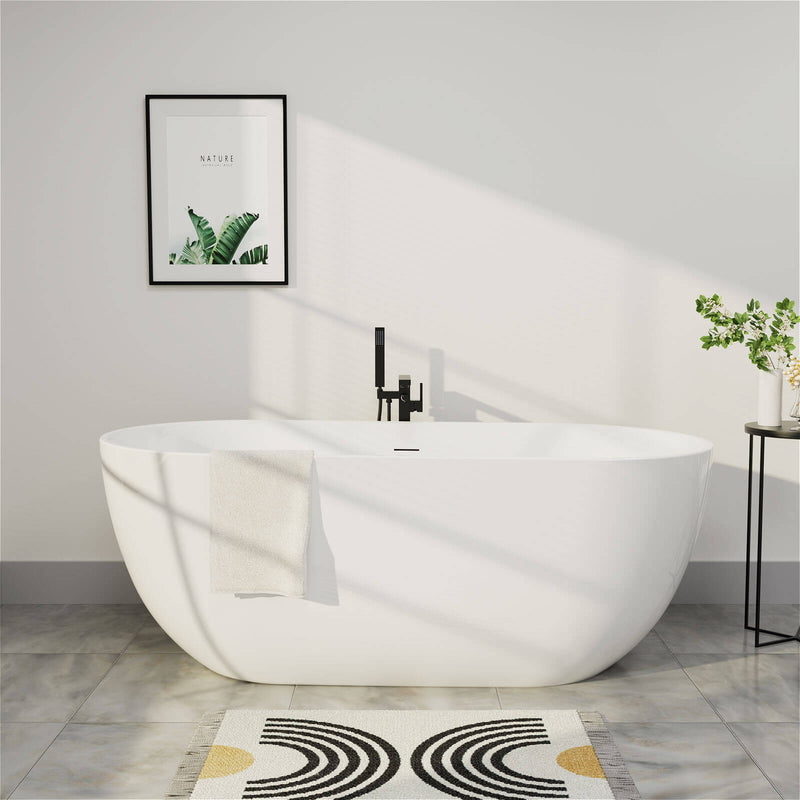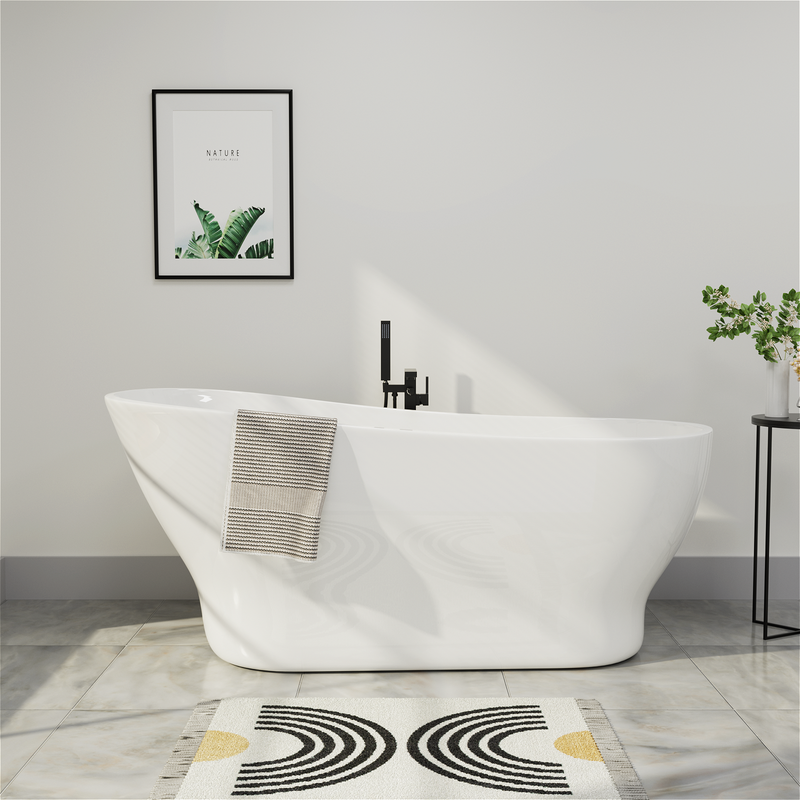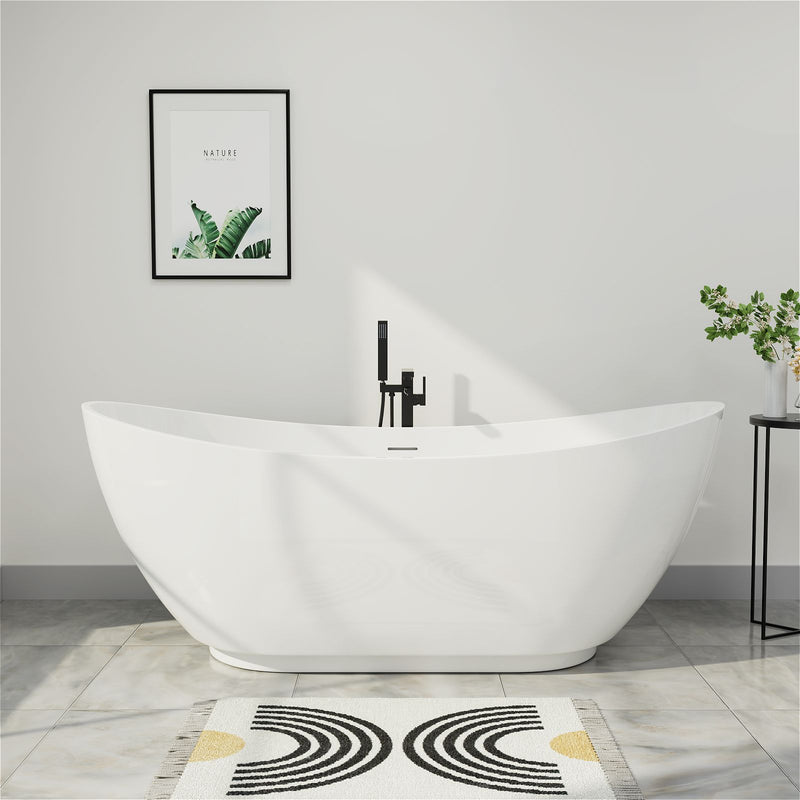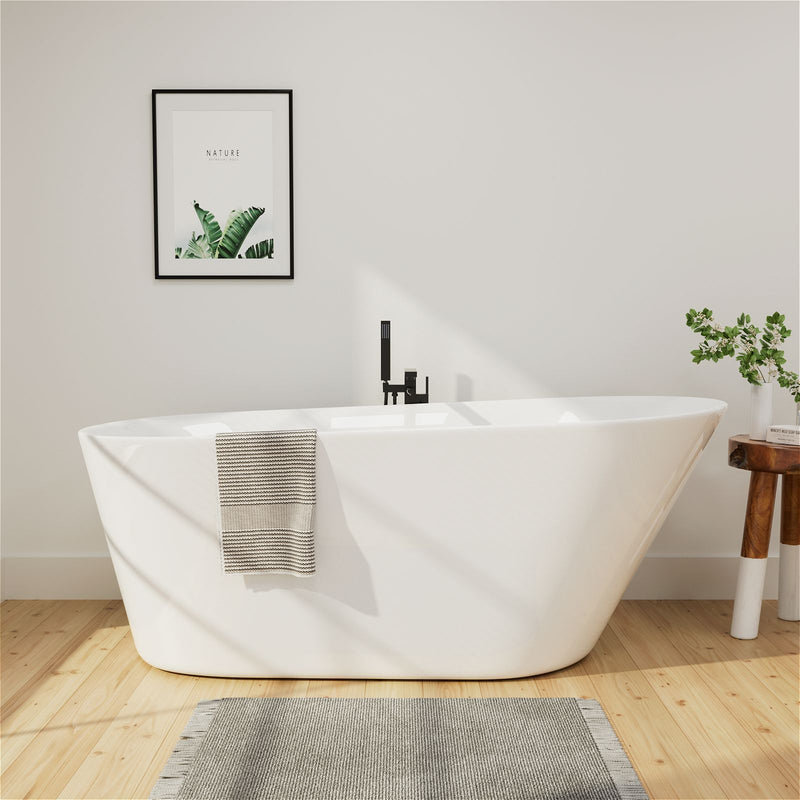Shower or Tub? Most American homes have a tub-shower combo in their bathrooms, and no matter your preference, you've probably experienced at least one of these. But what if you don't have a tub or shower? While showers are ubiquitous in American culture, some homes only have a tub, no showerhead, and no handheld showerhead.
But if you want to soak in the tub frequently, and you want a quick, refreshing shower whenever you want it, there are ways to add a shower to your tub that saves both water and time. Whether your upgrade is an easy, affordable, or expensive, depends largely on your tub and the type of shower you want.
Choose Your Shower
Ceiling-Mounted Showerhead
The minimalist design concept is to mount a ceiling-mounted rain showerhead directly above the tub. This creates a sleek, open feel without sacrificing practicality.
Freestanding Tub Faucet with Handheld Showerhead
Many luxury bathtubs come with a freestanding faucet that comes with a handheld showerhead. It replaces the existing showerhead and allows you to securely attach the showerhead using a hose. Choose the right hand shower, then find a bracket and/or wall bar to create a unique shower experience. This option offers the most flexibility and adds vintage or modern appeal, depending on the faucet style you choose.
Exposed Shower Enclosures
Another way to avoid touching the wall is with an exposed shower enclosure. These shower enclosures are a little more complicated to install, but these elegant packages can completely transform the layout of your bathroom. Typically, exposed shower enclosures are wall-mounted, and many have both a hand shower and a regular shower for ultimate convenience. Some even have a bathtub spout, just in case. You can choose a classic two-handle shower enclosure or a thermostatic shower enclosure, which can be set to a preset temperature for safety.
If you prefer an exposed shower enclosure, confirm that it is available before ordering. To do this, you will need to remove the existing bathtub handles, expose the water supply lines, and measure the distance between the centers of each hole (or the center of each pipe). This measurement will determine which valve, if any, is right for you. Most of the shower enclosures we offer are 3 ⅜ inches to 8 inches on center.
If you have a clawfoot or freestanding tub, or if you have a deck-mounted tub faucet, installing a tub/shower combination faucet can be a breeze. These faucets usually come with a tub filler, a shower rod, and a shower head.
Shower Curtain
When you have a shower, water is going to splash everywhere. While most of the water will go down the drain, some of it won't. You might think it's OK to have a tiled bathroom, but tile isn't waterproof, and neither is caulk, even if it's sealed. When a bathroom is built, special materials are used to protect the structure from water damage. So if you really want to add a shower, you need to decide how to protect the walls first.
The simplest, low-cost protection is a shower curtain. As long as there's good ventilation, a shower curtain rod surrounding the entire tub will absorb any spills. Shower curtains are usually hung from the ceiling or mounted on a freestanding shower enclosure, and are often the most elegant solution for freestanding or clawfoot tubs. If the tub is against a wall, a "D" shower curtain rod can be used to keep the wall dry.
If, for some reason, a shower curtain isn't enough, you'll need to consider the cost and time required to convert your bathroom into a proper shower. In addition to your existing shower, you'll need to install prefabricated shower walls (also called shower surrounds) or a whole new shower wall, as well as a shower door (usually mounted to the rim of the tub). Depending on the type of shower enclosure you choose, you may need to hire a contractor to help.
How to Add a Shower to a Freestanding Tub
Adding a shower to a freestanding tub typically requires installing a new faucet with a diverter, a shower head, and a shower curtain rod. You'll also need to connect the new shower fixture to the existing plumbing system and make sure it drains freely. While this project can usually be completed in a few hours, the exact time may vary depending on your skill level and the complexity of your bathroom's plumbing.
Tools and Materials
To complete this project, you will need the following tools and materials:
- Adjustable wrench
- Close-quarter tubing cutter
- Cordless drill/driver
- Grade
- Locking pliers
- Pipe brush
- Plumber's putty
- Propane blowtorch
- PVC pipe saw
- Shower curtain rod and brackets
- Shower head and arms
- Soldering materials (flux, lead-free solder)
- Teflon tape
- Tub filling kit with diverter
- PVC primer and cement
Installing the Shower
Step 1 Assess Your Bathroom Layout
Before you begin the installation, assess the layout of your bathroom to determine the best location for your shower fixture. Consider the location of windows, the orientation of the tub, and how you want to hang the shower curtain.
Step 2 Shut off the Water Supply
Safety is of utmost importance when working with plumbing. First, shut off the water supply to the bathroom's main water valve or well pump. This step prevents water from flowing during plumbing work. Also, open the faucet to drain any remaining water from the pipes and make sure the work area is dry.
Step 3 Prepare Existing Pipes
In order to install new fixtures, you will need to modify the existing plumbing system. This usually involves cleaning the exposed water supply pipe with an emery cloth and then cutting the pipe to the appropriate length with a close-quarter pipe cutter. You will also need to clean the pipe and apply flux to prepare it for the installation of the new fittings.
Step 4 Install Shower Components
Once the preparatory work is complete, you can begin installing the new shower components.
Step 5 Connect the Water Supply
To connect the water source to the new bathtub faucet and shower head, first weld the male fittings to the hot and cold water supply pipes. Wrap the threaded portion of each fitting with Teflon tape and install the shutoff valve on the fitting. Use a flexible water supply line to connect the bathtub faucet to the shutoff valve.
Don't forget to wrap the threads with Teflon tape to prevent leaks. Make sure the welded connection is tight and secure to minimize the risk of future water damage.
Step 6 Set the Drain
The new shower enclosure must be equipped with a suitable drainage system. When installing the drain, cut the existing drain pipe to a position slightly below the floor surface. Then, install the PVC fittings to the drain pipe with PVC primer and cement. Install chrome decorative covers on the fittings to make them more beautiful. Connect the bathtub's drain components, including the overflow pipe.
If the tub overflows, the overflow pipe will direct the water back to the drain, protecting the bathroom floor.
Step 7 Install the Shower
Once the plumbing is in place, it's time to install the shower. Install the tub faucet to the tub wall. Next, attach the shower head to the shower arm and the shower arm to the tub faucet. Install an adjustable ceiling bracket to support the shower arm. Use a level to make sure it's perfectly plumb before attaching the shower arm.
Step 8 Install the Shower Curtain Rod
Choose a shower curtain rod that matches the style and size of your tub. For claw-foot tubs, a round or oval shower curtain rod that wraps around the entire tub is usually the best choice. Make sure the shower curtain rod is made of a durable, rust-resistant material, such as chrome-plated brass, which will resist rust and last for years. Also, consider how the shower curtain rod will complement the other fixtures and decor in your bathroom.
When installing the shower curtain rod, use the brackets provided to secure the rod to the shower arm. Use a level to make sure the rod is perfectly level. Install additional ceiling brackets to secure the rod securely. Hang the shower curtain on the newly installed rod.
Conclusion
Whether you enjoy the relaxation of a bath or pursue the efficiency of a shower, the choice depends on your living habits and bathroom space. Through reasonable modifications (such as adding a handheld shower or a separate shower system), you can have both experiences. The key is to make decisions based on budget, installation difficulty and long-term needs, while ensuring that safety measures are in place (such as anti-skid mats and handrails). Make bathroom upgrades a wise investment in improving the quality of life!
FAQs
What are the benefits of adding a shower to a bathtub?
Adding a shower can save water and energy because showers are generally shorter. You can rinse off all the dirt and soap, and feel more refreshed even after a soothing bath. You can also clean the bathtub more easily.
Are there other things to consider when installing a shower in a bathtub?
Safety is the most important thing, you may want to buy anti-skid mats for standing, and add one or more handrails for stability when entering and exiting the bathtub, which will be very helpful.
Which is more water-saving, a shower or a bathtub?
Showers are generally more water-saving, with a 10-minute shower using about 25 gallons of water, while a bathtub requires an average of 35-50 gallons. However, if you take a long shower (more than 15 minutes), you may use more water than a bathtub.
Can a freestanding bathtub be retrofitted with a shower? What tools are needed?
Yes! You need to prepare a diverter faucet, a hand shower, a shower curtain rod, and plumbing tools (such as a wrench, PVC pipe saw). It is recommended to refer to the step-by-step installation guide in the article.
Will adding a shower to a bathtub affect the value of the house?
A properly installed shower combination usually increases the value of the house, especially for small families. But make sure to have complete waterproofing measures (such as shower curtains or shower enclosures) to avoid wall damage.
Can a bathroom without tiles be retrofitted with a shower?
Yes, but it must be waterproofed. It is recommended to use a shower curtain and waterproof pad, or install a prefabricated shower wall (such as acrylic panels) to protect the wall.





